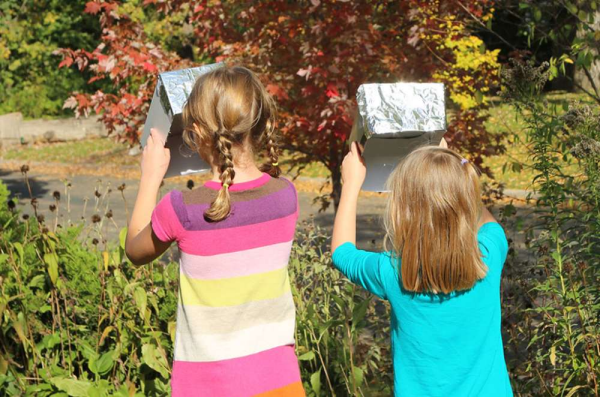On April 8, 2024, the moon will pass directly between the Earth and the sun over our heads, creating a total solar eclipse across a swath of North America. The entire contiguous United States will be able to observe a partial eclipse, but those lucky enough to live in (or travel into) the direct path of the lunar shadow will have a rare opportunity to watch the moon completely cover the sun and block out its light.
Even if you’re not in the path of the total eclipse, you and your family will be able to see the moon covering some of sun, and it will look like someone’s taken a bite out of it. Click on NASA’s map of the eclipse to see what time the moon’s shadow will be passing over your neck of the woods.
Since looking directly at the sun is extremely dangerous, you’ll need NASA-approved solar viewing glasses, an indirect projector, or this easy-to-make pinpoint solar viewer to safely observe the eclipse.
How to Make a Pinpoint Solar Viewer
You’ll Need
- Shoebox with lid removed
- Piece of white paper
- Aluminum foil
- Pin
- Tape
Safety Tips and Hints
Remind your child to never look directly at the sun. It could permanently damage her vision.
Have your child practice using the solar viewer before the eclipse, so she's an expert when the big moment arrives.
Supervise small children with pins.
What to Do

Step 1: Ask your child to cover one interior end of the shoe box with white paper to make a viewing screen.

Step 2: Cut a large, square notch out of the opposite end of the shoe box and tape aluminum foil over the notch you cut out.
Step 3: With a pin, have your child poke a hole slightly larger than the pinhead, in the center of the foil. If you make a mistake, replace the foil and try again. The smaller the hole, the sharper the focus will be.
Step 4: Go outside with your junior astronomer and stand with the sun directly BEHIND you.

Step 5: Have your child hold the box, opening-side down, with the pinhole pointed at the sun behind you. The foil should be behind your line of sight so it’s not reflecting the sun in your child’s eyes. Help correct the angle of your box so that the sun shines through the pinhole and its image is projected on the white paper as a tiny circle.
The Science Behind the Fun
When light rays from the sun enter the tiny pinhole, they form an upside-down image of the sun on the paper behind the foil. The image is flipped because of the angle at which the rays of light enter the pinhole and continue on to the paper. Even though the image is upside down, you’ll be able to watch the eclipse without looking directly at the sun.
© Quarry Books, 2016/Kitchen Science Lab for Kids; Featured Photos Credit: © Quarry Books
The eclipse lasts mere minutes, but if your child's enthusiasm for space and astronomy extends beyond the event, share these books about space below! Plus, click here for a free downloadable coloring activity inspired by the book Eclipse.
You can find all books and activities at The Scholastic Store.

